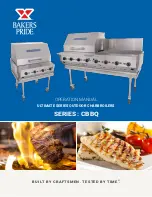
primary combustion area in the Wood Gun
TM
.
is
long Game path provides su<cient retention time for
the gases to cause near complete combustion to
occur before the hot gases come in contact with the
water-backed heat exchanger surface.
e mass of refractory that encompasses the
combustion chamber also serves a second important
function, acting as a heat store to initiate re-ignition
a9er a period of no demand. When the air valve
closes and the dra9 inducing fan stops, the re is
extinguished by lack of oxygen and becomes
dormant.
e re will re-ignite once the air valve
opens and the dra9-inducing fan is powered on, as
long as the refractory still retains enough heat to
cause combustion to take place.
e fuel may remain
dormant for periods of four hours or more
depending upon the size of unit and the temperature
of the refractory at shutdown. By utilizing this
combination of features, fuel is burned at maximum
e<ciency, only as heat is required, and never as a
low smoldering re. Smoldering res, and colder
than optimum res, produce excessive amounts of
creosote and smoke.
When a demand for heat exists, the operating
aquastat will open the air valve and activate the
dra9 induction fan. At this time, abundant air is
provided for combustion. When the boiler
temperature reaches the level set on the aquastat, the
fan stops and the air valve closes.
e fan that creates the negative pressure in the
combustion chamber inversely produces positive
pressure in the cyclone ash separator located at the
discharge point of the heat exchanger. Most of the
ash that remains a9er the wood is consumed is
collected here.
e Wood Gun™ is very responsive to heat
demand, especially when compared to conventional
wood boilers. Because of this responsiveness,
providing domestic hot water in the summer may be
practical. Alternate Heating Systems cannot promise
that summer time use of a Wood Gun will be
practical for you.
If summertime hot water requirements are low it
may be necessary to add a dra9 cycle timer to the
electrical control circuit to make the unit run for 8 to
10 minutes every two to four hours.
is will prevent
the re from going out and more importantly will
maintain su<cient temperature in the refractory to
ensure complete combustion on start-up.
is feature
will provide heat until the timer reaches the end of
the programmed cycle, or until the boiler
temperature high limit is reached.
It is essential that all combustion air be prevented
from entering the Wood Gun
TM
at shutdown. Where
a strong chimney dra9 is present during the o:
cycle, a unit with leaking door seals may allow a
small amount of air to be pulled through the unit,
supporting a low-grade re.
is produces two major
undesirable results.
First, incomplete combustion yields creosote and
other organic compounds, which are mildly acidic.
ese condense on the water walls of the load
chamber and heat exchanger. If this situation is
allowed to continue for any length of time, the heat
exchanger will become coated to the extent that
airGow and heat transfer are seriously impaired.
e second undesirable result is moisture
condensation.
is occurs because the low-grade re
produces insu<cient heat to carry the water out the
stack as water vapor. Water will likely be evident in
the ash pan and, in severe cases, may even collect in
the heat exchanger.
is water comes not only from
- 3 -
Note: Some of the byproducts produced by
incomplete combustion of wood are
formaldehyde, formic acid and acetic acid, which
are mildly corrosive. A Wood Gun™ operating
under light demand may never generate
refractory temperatures sufficient to reduce these
organic compounds to water and carbon dioxide.
Any air leak around the inspection doors or air
valve may contribute to the formation of
corrosive products. Therefore it is important to
inspect your Wood Gun™ regularly to ensure that
it is being operated in a manner that does not
contribute to excessive corrosion of the steel. We
recommend that boilers operating with lower duty
cycles be manufactured with the stainless steel
option. It does not override the high limit.
Summary of Contents for wood gun E100 SF
Page 2: ......
Page 24: ...Photo Smoke flap installed 19 ...
Page 46: ...Steel Center Brick 8 Inch 41 ...
Page 49: ...Appendix A Boiler Specification Diagram 44 ...
Page 50: ... 45 ...
Page 51: ... 46 ...
Page 53: ...Appendix B Wiring Diagrams 48 ...
Page 54: ... 49 ...
Page 55: ... 50 ...
Page 56: ... 51 ...
Page 57: ... 52 ...
Page 58: ... 53 ...
Page 59: ... 54 ...
Page 60: ... 55 ...
Page 61: ...Appendix C Exploded Parts Drawings 56 ...
Page 63: ... 58 ...
Page 68: ...Appendix F Boiler Piping and Ducting Examples 63 ...









































